
RNZAF/USAF F4 Phantom Exchange Posting 1979-1982 – Sqn Ldr Jim Barclay RNZAF
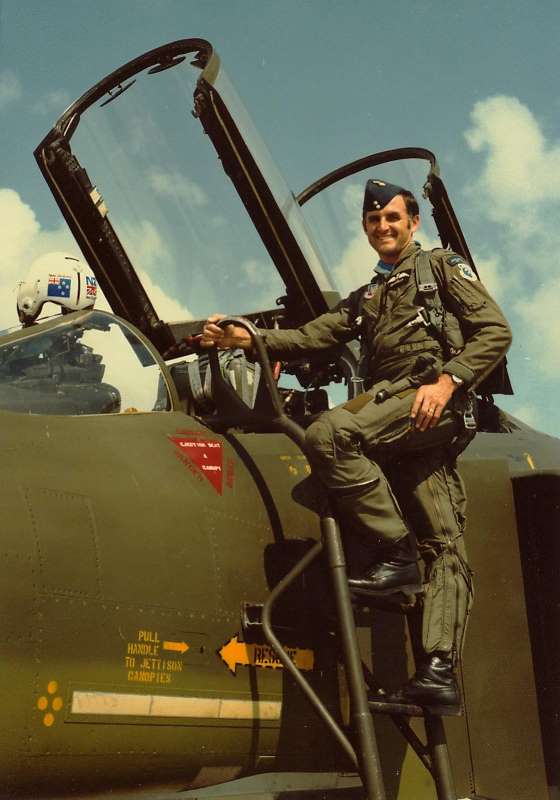
In May 1979 I travelled to Florida, USA, with my family for a ‘two-years, plus training time’ RNZAF/USAF exchange posting flying the USAF F4 Phantom II with the 31st Tactical Fighter Wing (31 TFW) at Homestead Air Force Base (HAFB), Florida. Having completed my F4 Conversion course, followed by my F4 Instructor upgrade, I served as a F4 Instructor pilot (IP) at HAFB for two years from January 1980 until January 1982, firstly on the Phantom F4E and then the F4D.
I did get to see some of USA when I travelled on leave with my family. I was also successful on five occasions over two years to take an F4 ‘cross country’ for a weekend, which was something the USAF encouraged IPs to do from time to time so they could get out of the local 31 TFW training areas where they were like ‘moths around a light bulb’. I spent three weeks at the Tac Aces Simulator at Luke AFB, Arizona; and I flew for two weeks in the excellent operational training ‘Exercise Maple Flag’ held at Cold Lake AFB, Alberta, Canada in late 1980. I also did my bit as a F4 simulator instructor at HAFB as well.
My exchange posting was a highly rewarding experience and I learned a great deal, much of which I was able to use when I returned to New Zealand as CO 14 (Strikemaster) Squadron, a little later as CO 75 (A4 Skyhawk) Squadron, and as Base Commander, RNZAF Base Auckland.
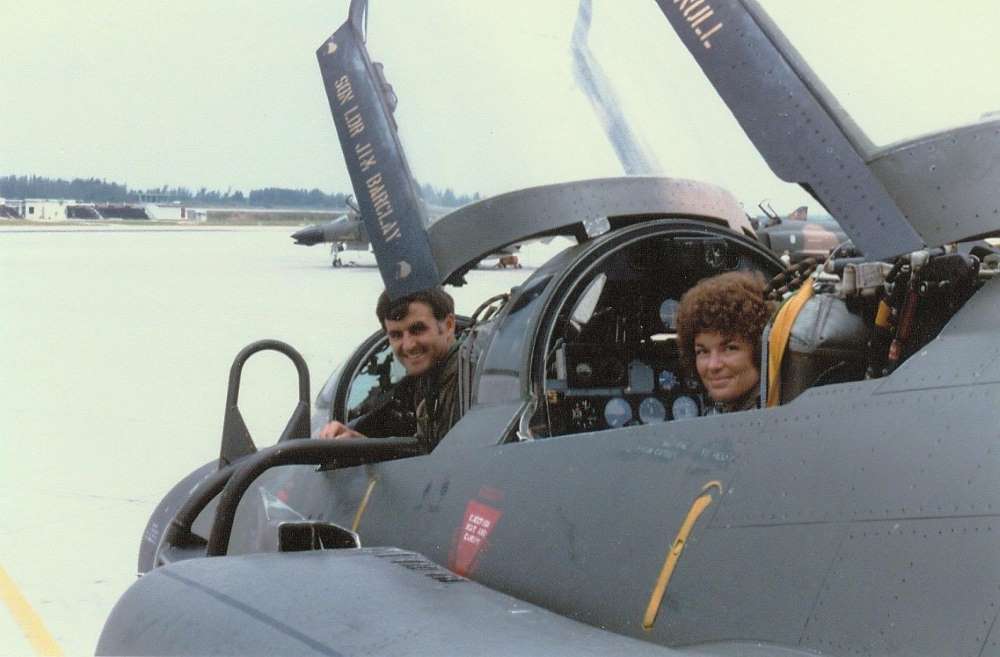
Background – By way of background, I had flown Vampires at RNZAF Base Ohakea in 1969 and 1970 before converting to the RNZAF’s new A4K Skyhawk in 1970. I last flew the A4 operationally in late 1973 before I was posted to a ‘ground job’ in Singapore. In 1976 I completed a Flying Instructor’s Course at RNZAF Base Wigram on the Harvard before instructing pilot trainees on the Harvard until it was phased out of service in mid-1977 and replaced by the CT4B Airtrainer. I was posted to Central Flying School at Wigram in January 1978 and then to an exchange posting with the USAF from 29th May 1979. Before leaving for USA I was a little concerned about my lack of recent ‘fast-jet’ experience; afterall, it had been nearly 6 years since I had flown the A4 operationally and I was about to go from a fixed undercarriage two-miles per minute CT4B Airtrainer to a supersonic F4 Phantom II, something I termed with a little trepidation “one small step for mankind” (with acknowledgement to the first man on the moon, Neil Armstrong).
My initial Ad Hoc F4 Conversion course – But there was more to be concerned about….. When I got to HAFB, as their first RNZAF/USAF exchange pilot, an experienced USAF F4 IP who was running the STU (Special Training Unit) incorrectly assumed I had flown the F4 before. Accordingly, I was put on a localised short 51/50 ‘refamil’ F4 course. In addition to getting my wife and family settled, buying a car and getting a Florida drivers licence, getting the kids into Summer School and Kindy, I completed a self-paced F4 tech training package. On 18th June I had two 1.2 hour F4E simulator rides, and another two on 20th June, before my first F4E flight on 21st June 1979. After three 1.6 hour ‘Transition’ F4E flights over four days, I got into the air combat phase of the F4 ‘refamil’. After four of these flights over the next four days I felt the learning curve was really too steep and I was ‘drinking from a firehose’; so, I told the IP that as a ‘newby’ to F4s I was struggling and frankly I didn’t think much of their rather ad hoc F4 conversion course. He retorted by saying he thought I would have been better than I was, as, according to my records, I had flown the F4 before. I said I had never flown the F4 before. He said I had (!!) and stormed over to the filing cabinet to get my file – it showed my 750 hours on the A4, but nothing about the F4. Somewhat embarrassed, he asked what an A4 was, and I told him it was still in service with the US Navy! Now incredulous, he asked if I meant I had flown the ‘Scooter’? “Call it what you like,” I said, “but I have not flown the F4”.
Colonel Gene Fischer, at that time the Deputy Commander of 31 TFW, came over to my quarters later that day to say, “Kiwi, we have egg all over our face. How can we begin to apologise.” We agreed that I would be put onto the longer F4 CBH or ‘B’ Course (rather than the shorter ‘T’ course which was designed for those who had flown the F4 or 100 series fighters before). After completing the applicable parts of a full ‘B’ course, I would need to do the ‘I’ (Instructor) Course. On the ‘I’ course I would learn to fly the F4 from the back seat, including working the air intercept radar, the integrated Weapons Release Control System (WRCS) including the offset bomb and toss bombing computer features, et al. As it turned out, the time taken to complete both the ‘B’ course and the ‘I’ course was just on 10 months.
Back to more detail of the F4 Conversion – Now, backing up to my arrival at HAFB I did my ‘B’ course from 3 Jul 79 to 19 Oct 79 with the 309 TFS (the Wild Ducks) on the F4E LES (Leading Edge Slats) aircraft. At the end of the conversion course I had accumulated 88.7 F4 flying hours comprising 52.4 hours Dual Day, 8.2 hour Dual Night, and 28 .1 First Pilot Day. I had also done a further six F4E simulator rides of 1.5 hours each. For the end of my ‘B’ Course, the ‘Assessment of Proficiency’ in the rear of my RNZAF Pilots Log Book records: – for Pure Flying -“Well above average for this course’; in the Fighter Role -“Aircraft Commander/Ground Attack, Strike – Excellent; In Air Weapons “Air to Air F4-E employment – slightly above the average”; Comments – “A very professional and personable aviator and Officer who conscientiously applied himself to all tasks and did exceptionally well in this course. It is a pleasure to have and officer of this high calibre abroad.” Signed – Ralph E Beekman Lt Col 309th TFS.
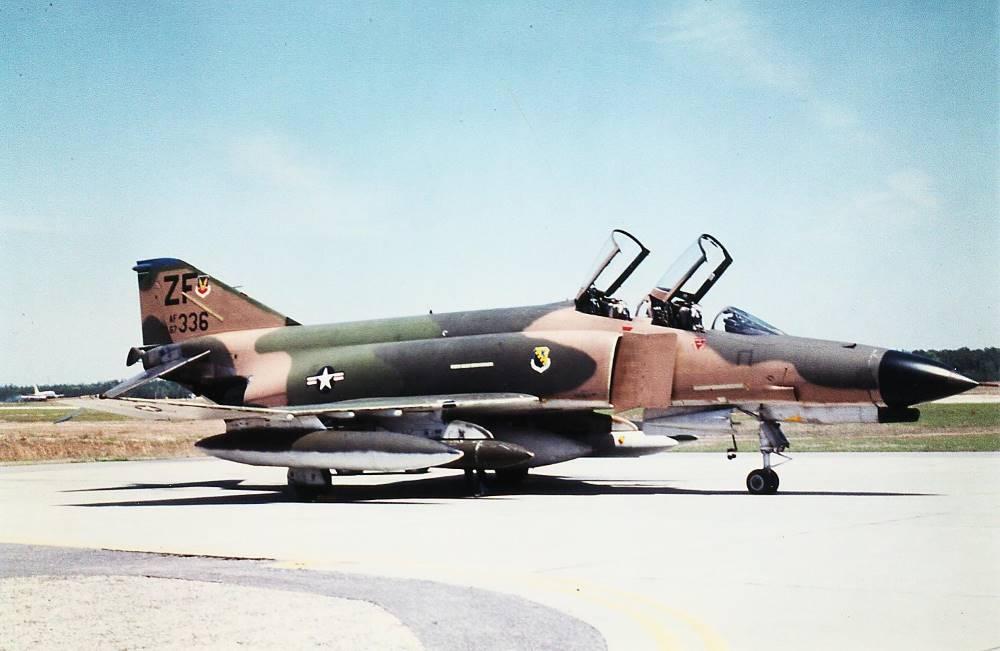
More detail on the Instructor Upgrade course – On completion of the ‘B’ course, I then did the ‘80 AIH ‘I’ F4D Instructors Course from 22 Oct 79 till 15 Jan 80 with the 306 Tactical Fighter Training Squadron (TFTS), (named the ‘Combat Rabbits’) on the older F4D. Here I amassed a total of 50.4 flying hours comprising 9.4 hours Dual Day, 34.9 hours First Pilot Day, and 6.1 hours First Pilot Night. I also did a three more F4 Simulator rides, two of 2 hours duration and one of 1.5 hours. At the conclusion of the course I was very surprised to be presented with the 80 AIH ‘Top Student’ award. My Log Book ‘Assessment of Proficiency’ states :- Pure Flying – “Exceptional”; in RTU/Fighter Role “Air-To-Ground Instructor – Exceptional”; In Air Weapons –“Air-To-Air Instructor, Exceptional”; Comments -“Top Graduate, Class AIH – Sqn Ldr Barclay performed as an absolute professional in every way during this course. His thorough, exacting briefings were models for students and instructors alike to emulate. Signed – Omer L Ward Jr, LTC. 306 TFTS”.
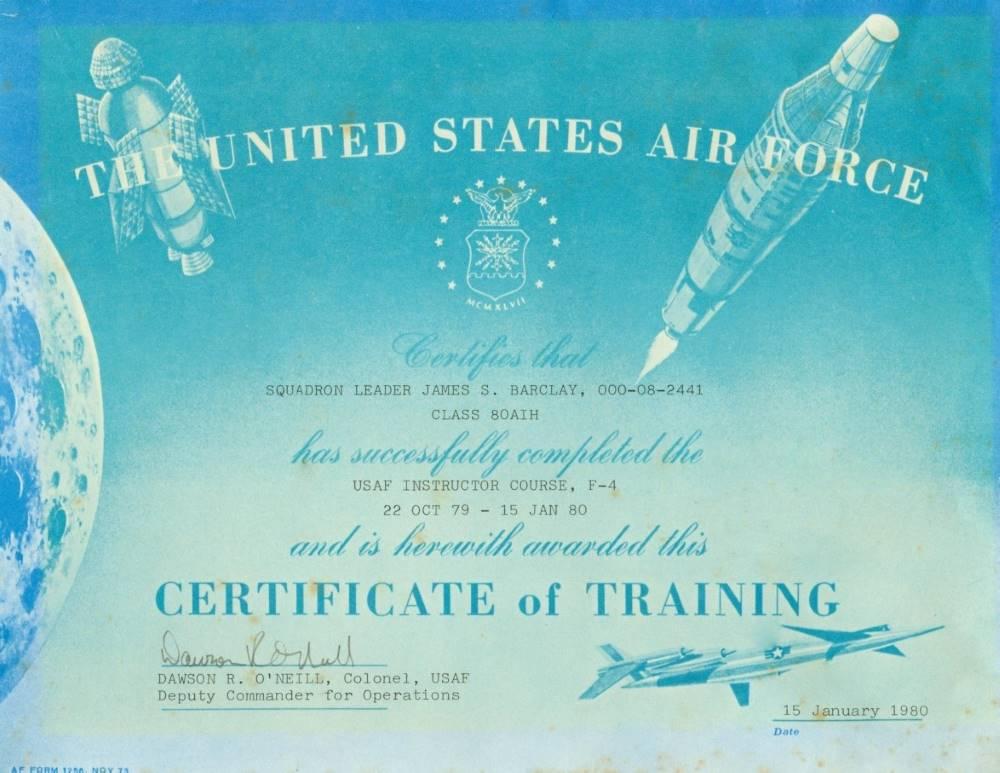
Starting out as an IP – With a grand total of only 141.4 hours on the F4, I then went back to the 309th to fly the F4E LES, but this time as an F4E instructor. At the time I felt I was barely one step, with only a ‘smidgeon’ of experience, ahead of my ‘pupils’. I stayed on the F4E with the 309th until the F4Es were phased out at the end of June 1980 from the remaining three 31 TFW squadrons (the 307th, 308th and 309th had F4Es, but the 306th already had D models). This happened because 31 TFW was directed to send about 34 of its 100 F4Es to Egypt (as part of the Pres Jimmy Carter/Pres Anwar Sadat ‘Camp David Peace Accords’), and the rest of the 31 TFW F4Es (about 75 of them!!) went to operational USAF squadrons, whereupon we got their older F4Ds – and that was “one great rearward step for mankind”, as I remember saying.
My re-assignment to the 308th TFS – In September 1980 I was reassigned to the 308 TFS (the Emerald Knights) to fly the F4D and I stayed with the 308th until I returned to New Zealand in January 1982. I was reassigned from the 309th because the squadron was to relinquish its training role and become an ‘operational’ unit, and at that time a foreign exchange officer could not be on the strength of an operational USAF fighter squadron. However, just before the 309th was to become operational, the change was cancelled. I was then rather humbled by the tug of war that developed between the Commander (CC) of the 309th, who wanted me to stay, and the 308th CC who wanted me to go to his squadron as promised. To sort out the stalemate they individually bribed me with beer at the Officers’ Club before asking where I wanted to go – but I said they should sort it out themselves and let me know the outcome. So, one Saturday morning, the two squadron commanders met with the 31 TFW Director of Operations (DO) for a ‘showdown at OK Corral’; afterwards, the CC of 308th called by my on-base house and triumphantly declared he had ‘bagged a Kiwi’!

Now for some ‘stats’ – For the two years I was instructing on the F4, I notched up 261.8 hours in 1980, and 310.9 hours in 1981. I averaged 21.8 hours per month for 1980 and 25.9 for 1981. Each flight, or sortie, averaged 1.4 hours. I flew 192 sorties in 1980 and 222 in 1981. The highest number of hours I flew in any one month was 35.7 hours in 1980 and 34.1 hours in 1981, and the lowest were 9 hours and 7 hours respectively (reasons for low hours included being at the Tac Aces simulator for 3 weeks, as well as taking leave with my family to visit places in USA). As a F4 IP, I used to fly in the back seat of the F4 when I had a trainee pilot ‘up front’ and in the front seat when I had a trainee Weapons System Operator (WSO) in the back – so about 50 % of the 720 hours I flew on the F4 was spent in the back cockpit (it was called ‘The Pit’!).
Most IPs did one flight per day, but as I was not qualified (because I couldn’t have a USAF Drivers Licence [but could fly their F4!]) to sit in ‘Mobile’ caravan checking undercarriage at the end of the runaway, or do periodic Wing Supervisor of Flying (SOF) from the Control Tower (you needed to be Mobile qualified, and I wasn’t!), or be Range Safety Officer at Avon Park weapons range, or be rostered to sit in the end-of-runway ‘Alert Shack’ doing 24 Hour ‘Alert’ with live air-to-air weapons, I was around the squadron more so I was able to occasionally ‘score’ two flights in one day.
But, two flights (‘double banging’) in a day came at a price in the name of fatigue – a typical flight took some 5 hours from ‘go to whoa’: backing up to two hours before take-off, the first hour was allocated for flight and individual/crew pre-flight briefings, and the second hour was required for ‘stepping’ from the Squadron Ops building to collect and don flight gear (G Suit, Torso Parachute Harness/Survival gear and collect helmet bag with Bonedome and oxygen mask) at the adjacent air-conned Safety Shop, walk (or sometimes ride in the squadron’s step-van) to the Flightline, locate the allocated F4 from the many numbered rows on the ‘ramp’ containing over 100 F4s, pre-flight, start, taxy, takeoff). Up to 2 hours was required for the flight, and one hour to debrief and write up the student’s sortie Gradebook. Do two 5-hour ‘flights’ in one day in tropical heat and you were pooped, especially if you were the Flight Leader and had to prepare the sortie/mission Brief and set up the briefing room before conducting the brief itself, lead the flight, and then lead the debrief.
My F4 Flying – Now let’s turn to what an F4 IP did. There was a written syllabus for all the F4 courses and each sortie in each course followed a typical ‘building block’ pattern by starting with the basics, and as skills developed, introducing and building in more complexity. We often referred to this process as ‘first, learn to crawl, before walking, and running’. Thus the syllabus was built up by first learning how to fly the F4 competently and safely in day/night and in instrument conditions. Once a pilot was proficient in flying the F4 and was independently checked and signed out to be an Aircraft Commander, the sortie complexity could be gradually and carefully expanded so that by the end of the course the aircraft could be used as a platform to deliver weapons. Air-to-air and air-to- ground ‘phases’ of the courses started out by working as a single aircraft in order to develop individual skills before building in firstly two and then more complex four aircraft exercises. By the end of the course more advanced tactics were introduced and multi-aircraft packages were flown. The common phases flown were as follows:
- Transition (TR) phase – The TR phase involved upper air work including high speed and low speed handling, approach to and recovery from low speed stalls and high ’G’/high Angle of Attack (AOA) situations that could cause the aircraft to ‘depart’ stable flight, use of the AOA Indexer and Aural Tone system, in the F4D the use of rudder but not aileron to turn at high AOA, aerobatics, instrument and visual approaches, traffic patterns (circuits to Kiwis!) being flap and no flap, single engine, use of the Drag Chute, arrested landings etc. At the end of this phase the pilot would be independently checked before the being signed out as a certified Aircraft Commander.
- Basic Fighter Manoeuvre (BFM) – The aim of BFM phase was introduce the pilot and WSO to the basic concepts of using the F4 in air combat. Skills learned included 3 mile radar trail departure, F4 radar controlled tactical intercepts, close formation flying, 1V1 manoeuvring from ‘canned’ setups to a predicable ‘duck’ target in order to simulate the use of missiles and guns, ‘com out’ turns (i.e. no radio), rollslides (I used this technique to ‘gun’ a B52 at low altitude on Exercise Maple Flag!)
- Air Combat Manoeuvres (ACM) – the ACM phase built on the basic principles learned in BFM and applied them to more complex and free-flow 2v1, 2v2 air-to-air scenarios.
- Air Combat Tactics (ACT) – the ACT phase introduced sequential attacks in 1 v 2 and 2 v 2 scenarios.
- Dissimilar Air Combat Manoeuvers (DACM) & Dissimilar Air Combat Tactics (DACT) – The DACM and DACT phases gave exposure to different/dissimilar adversary aircraft such as the F5 ‘Aggressors’ from Nellis AFB that flew as if they were a Mig 21, or against the F16, F15, and USN A4 aircraft.
- Ground Attack Radar (GAR) phase – (often the Ground Attack phase was flown after BFM and before ACM/ACT). The F4 had a multi-purpose Radar and a Weapons Release Computer System (WRCS) that integrated with an Offset Bomb capability and a Pull-Up and Release Timing system. It could also be used for delivering tactical Nuclear weapons. The GAR phase introduced pilots and WSOs to the high speed low level ‘Toss’ and ‘Laydown’ capability of the F4. These attack profiles could be done either visually, or by the use of the integrated F4 radar and WRCS systems. Attack profiles included: – a Visual Low Alt Drogue Delivery (VLADD) using a Mk 106 practice bomb delivered at 500Knots/300 feet, a Visual Laydown Delivery (VLD), and use of the F4 radar/WRCS for a RLADD or Radar Laydown (RLD) attacks.
- Air Refuelling (AR) at Day & Night – the AR phase involved air refuelling from a USAF KC135 tanker where the Tanker’s boom operator inserted an extendable probe into the F4 air refuelling receptacle. AR was done by day and night and as it depended on Tanker availability, it was done in conjunction with a number of other sorties except TR.
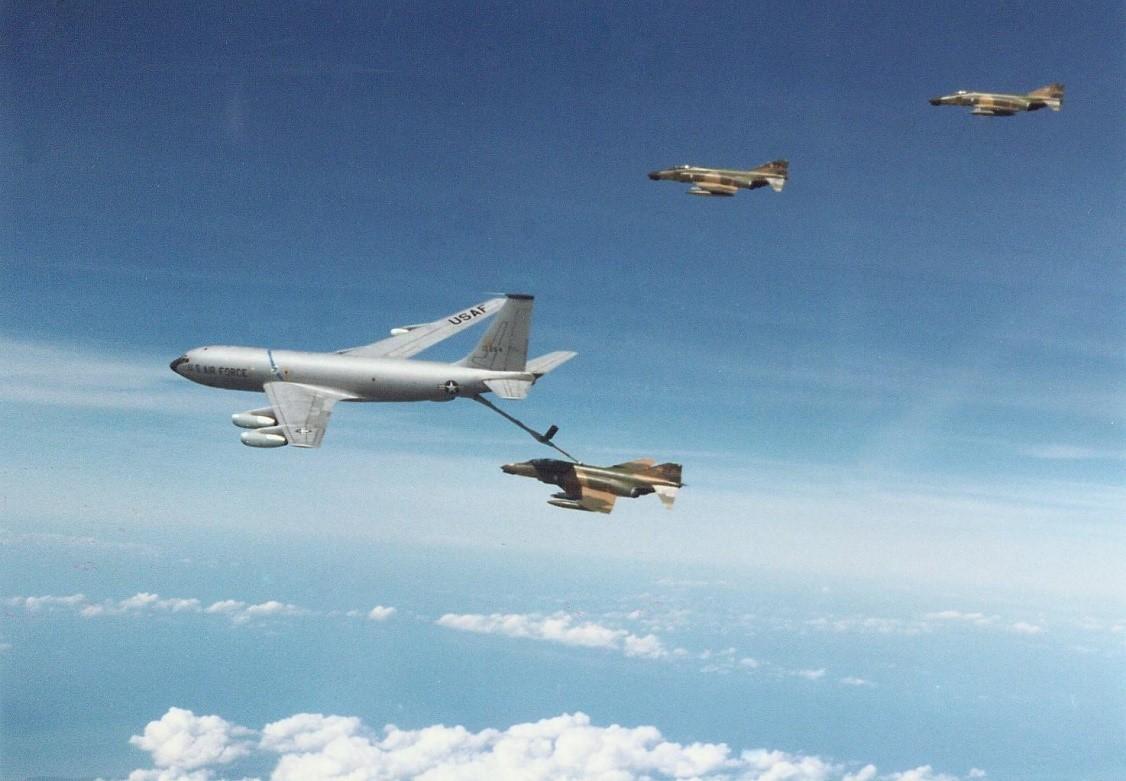
- Ground Attack (GA) – The GA phase involved learning weapons delivery at a scored range from the following profiles:- 10 deg (dive angle) strafe normally using 100 x 20mm bullets from the very accurate Gatling six-barrelled Vulcan canon (it was fitted into the nose of the F4E, but came in a wing-mounted gun pod in the F4D), 10 deg Low Angle Bomb (LAB), 20 deg ‘Dive Toss’ (using the F4 radar to lock onto a ground return and give slant range to the target), 20 deg Low Angle Low Drag (LALD), 20 deg curvilinear, 30 deg Dive Bomb and Dive Toss, 45 deg Dive Bomb and Dive Toss.
- Night Flying (NF) – the NF phase was of one or two night TR and close formation sorties that were done before the night AR and GAN phases (see below).
- Ground Attack Night (GAN) – the GAN phase included 20 deg LALD, 30 deg Dive Bombing and Dive Toss on the scored weapons range against a lit target, or under a C130 dropped parachute flare.
- Ground Attack Tactical (GAT) – the GAT phase brought together all the skills learned in earlier phases in order to carry out attacks against targets on the Tactical Air Weapons range. New skills introduced included low level target ingress from an Initial Point (IP) at 540K/ 300 feet and a ‘pop up’ to deliver bombs or gun passes on a tactical ‘airfield’. Realistic targets included parked aircraft, petrol and oil (POL) stores, SA2 and SA3 missile sites, 57 mm gun sites, airfield control buildings and bunkers. As the Phase progressed the complexity of attacks increased from initial single aircraft attacks through to more complex pairs and 4 ship attacks. Electronic threats were introduced from ground emitters such that the F4 Radar Warning Receiver (RWR) activated and pilots were required to recognize the threat and deploy chaff and flares. Jinking after weapons release and low level egress from the target area at 620K/300ft were practiced.
- Red Banner exercise – This was the final graded end-of-course sortie for each pilot/WSO wherein they were required to plan, co-ordinate and execute a totally ‘com-out’ multi-aircraft attack on a Tactical weapons range with added random attacks by ‘enemy’ fighters.
- Hot Pit refuelling – from time to time aircrew and ground crew were required to exercise the procedures to refuel the F4 with fuel pumped from a fuel supply at a designated refuelling area (the Hot Pit) with one F4 engine running. After being refuelled the aircraft returned to shutdown at dispersal on the flight line. This practiced procedures that could be found under operational conditions where fuel tankers may not have been available.
The Sortie Goal System – Each course, be it a ‘B’ Course or ‘T’ course, worked to a pre-determined course finish date, and just like a sausage machine, the course had better be finished on time because the next one was coming along right behind. The finish date was determined by the total number of sorties required to complete all phases of that course, multiplied by the number of students, plus a small ‘slippage’ factor. When the total number of sorties was broken down it gave a ‘goal’ being the number of sorties required to be flown each day to make the finish date. Each of the four F4 squadrons worked to their daily/weekly/monthly sortie goals and the 31 TFW aggregated these figures for all four squadrons to show the Wing’s monthly goal. If the monthly Wing goal was achieved by one of more days ahead of the plan, then the whole Wing got the first Friday off work (called ‘stand down’) in the following month. The sortie goal system was a powerful incentive for the whole Wing to pull together and work as one to achieve the goal so they would all get a day of stand down. Daily sortie goal progress was displayed for all to see on a big notice board just inside the main entry gate to the Base, and on that board each squadron’s sorties were displayed as a ‘+’ or ‘–‘ figure against its own goal, as well as the aggregated total that showed the Wing’s progress.
Accountability – The CC of 31 TFW (the Wing Commander) held a ‘Stand-up’ (as the CC came into the room, of course!) briefing session at 4.00 pm each day. ‘Stand-up’ was attended by the Wing DO and the CCs of each of the four F4 squadrons (or his senior rep), plus CCs of each of the key and important functions on the Base, including the big Maintenance and Supply Wings. Each flying squadron tabled an Over Head Projector slide (OHP – pre computers!) to show the sorties achieved-versus-planned for the previous day. The principle “if you measure it, you can manage it” applied, and so sorties not flown (deleted) specified a reason for the ‘delete’. When each OHP was shown in turn on the big screen the ‘fur started to fly’ as claims and counter-claims were voiced as to the actual reason for any one ‘delete’; it seemed to be a process of trying to ‘make it someone else’s problem, and so shift the heat’! The most common reasons for a ‘delete’ were as follows:-
- an ‘Ops delete’ – reasons included a pilot/WSO who became unfit to fly and a substitute was not available in time, or a take-off was outside the 15 minutes the very extensive daily flying plan specified due some Ops/Air Traffic etc reason, but there weren’t ever many Ops deletes.
- a ‘Maintenance delete’ – reasons included an aircraft not being available in time to make the scheduled takeoff window due to things like slow or no refuelling/weapons loading/broken part etc – and the maintenance guys were always looking for ways to push their ‘delete’ onto others including the Supply guys for not having a replacement part, or not supplying it in time.
- a ‘Supply delete’ – this was invariably due to not having the required spare parts in time. Raiding parts off another downed aircraft was frowned upon as it doubled the workload.
It goes without saying that one needed to do their homework well before getting to ‘Standup’ as answers to the CC’s questions from those in the ‘hot-seat’ were required on the spot. Accountability mattered a great deal and if repeated weaknesses were shown up by performance measurement, an officer would quickly be replaced. Courses needed to graduate on time so the decisions and the outcome of ‘Standup’ rippled down through the chain of command in order to constantly sharpen individual and unit performance. All of this process was based on years of experience including relatively recent USAF combat experience in Vietnam. It was a good system and it worked.
Some brief observations on the F4 Phantom II are as follows:
- The F4 Phantom II – Wikipedia tells us “The McDonnell Douglas F-4 Phantom II was a tandem two-seat, twin-engine, all-weather, long-range supersonic jet interceptor and fighter-bomber originally developed for the United States Navy by McDonnell Aircraft. It first entered service in 1960 with the US Navy and entered service with the USAF in the mid-1960s.” The USAF F4s saw extensive service in the Vietnam War. The F4 was known by many names including “Double Ugly”, and, “The Rhino”. It was a mean looking aircraft with its tilted-down anhedral stabilators on the tailplane, and cranked up dihedral wing tips. As a fighter it was big, wide, old, very versatile, and the engines were smokey – but it was a man’s aeroplane! It had two General Electric J79-GE-17 engines of 11,990 lbs static thrust for each engine in ‘Military’ power, and 17,800lb each in after-burner.
- With its crew of two, the F4 had three main roles:- as an air-to-air Interceptor, a ground attack ‘mud-beater’, and to deliver Tactical Nuclear bombs. In comparison with other role-specialist aircraft the F4 seemed perhaps to be a “Jack-of-all-trades, but master of none”. While the F4 was good when used in any one of its three major roles, it seemed there were other specialists that could do one role better – but not them all as the F4 could do. By the time I flew the F4 in 1979-1982, its technology was considered to be dated, or old. It needed two crew members, one to fly the jet, and the other to work the radar and systems, whereas in the new single pilot F15 Eagle air superiority fighter the radar was semi-automatic in search, tracking of targets, acquisition etc. Having said that, the multi-role F15 Strike Eagle, with two crew members, would come later!
- Speed – The maximum speed for the F4 was 750 Knots at low level and at high level it was 710K/Mach 1.9 at 30,000ft, or 710K/3 at 43,000 feet. Even while carrying two 370 gal drop tanks, M1.6 was easily attained in the operating areas out over the sea to the east of the Florida Keys. The normal speed we used at Low Level was 420K (7nm/minute], and we pushed it up to 540k [9nm/min] for a run-in to a Pop-Up weapons delivery. In the days before moving map displays, pilots liked to work in round numbers of miles/minute as it made it quicker and easier to mark off a hand-held trimmed and sectioned map at one-minute elapsed time intervals from a datum point to the next low level navigation turning point, or to the IP or target. The F4D was said to be a little faster than the F4E, but who wants to split hairs at Mach 1.4!
- Weight and Fuel – The empty F4 Operating Weight was about 32,000lb. At HAFB, the F4 was normally operated with two x 370 gallon drop tanks that were carried under the wings giving 4500lb of JP4 fuel. The total internal fuel carried in the aircraft was 13,000lb – there were 7 internal fuel bags along the top of the fuselage (6 in the F4D) [these 7 were needed to keep the C o G and C of P within limits when the aircraft went transonic], as well as more internal fuel inside the wings. So, the All Up Weight (AUW) on a normal training sortie was 32,000lb + 13,000lb internal fuel, + 4500lb in the drop tanks = AUW 49,500lb at T/O. The maximum fuel able to be carried was 21,600lb, made up of Internal fuel of 13,000lb + 2x370gal wing tanks at 4500lb, and one 1x 600gal centreline drop tank at 4,100lb. The two Fuel Flow Gauges in the cockpit were marked up to 12,000lb/hr maximum – but fuel flow was FOUR times that amount that in After Burner, so burner was used very sparingly!
- Max T/O/Landing Weight – The maximum F4 take-off weight was around 58,000lb (the RNZAF Canberras were about 63,000lb MAUW, and the RNZAF A4K Skyhawk was 24,500lb); and the maximum landing weight for the F4 was 46,000lb.
- Takeoff using the normal full After Burner – the nose wheel lift-off speed on takeoff was about 146K, and takeoff speed about 170K, with a ground run in light winds of about 2500ft
- F4D ‘blown’ Flaps – The F4D was fitted with Leading Edge flaps, as well as trailing edge flaps. In the approach and landing configuration, with landing gear down and the leading edge and trailing edge flaps out and down, the F4D had an over-wing ‘blown’ airflow boundary layer control system that directed high pressure airflow over the flaps. This permitted improved low speed handling of the aircraft.
- F4E Leading Edge Slats (LES) – Instead of having leading edge ‘blown’ flaps as on the F4D, the F4E was fitted with Leading Edge Slats (LES). For takeoff and landing the LES operated in conjunction with the trailing edge flap switch so the slats were out; for inflight manoeuvring, with the landing gear up, the slats extended automatically as a function of AoA, being fully out at 11.5 units AoA, and back in at by 10.5 units as AoA reduced. With its LES, the F4E could turn better than the F4D, but you had to be careful as the better turning capability of the F4E could lead the novice or unsuspecting pilot to try and turn tightly in a dogfight against a more agile adversary, and with the big delta wing on the F4, airspeed would bleed quite quickly. The F4 wouldn’t fly much at or below 250 knots so it became ‘dead meat’ to an adversary. The message a good IP always drummed-in was “Speed is life. Remember to employ the principles of Kinetic energy:- convert your speed to height and height to speed to make slashing weapons attacks, but don’t sacrifice speed by getting into a turning fight. In the F4, keep the fight big.”
- AoA Aural Tone system and F4D Pedal Shaker – The F4 had an AoA aural tone system (and a stick and pedal shaker in the F4D) – which was something very new to me in flying with a tone in my ears! The tone ‘beeped’ as the aircraft approached Optimum AoA, and it gave a steady tone at and around Optimum AoA. The frequency of the beep increased as Optimum was exceeded. When you got used to using it, the steady ‘on-speed’ tone indicating you were at optimum AoA was great for use in air combat. The Aural Tone system was great! And the F4D’s stick & pedal shaker was very useful in avoiding an imminent high AoA ‘departure’ from controlled flight, and the possibility of entering the dreaded flat spin.
- Approach and Landing – with gear & flaps down, LES in or out [on the F4E], ‘on-speed’ or at optimum AoA, and with 2500lb fuel, the approach speed was around 154K. The Minimum Fuel required on final landing was 2000lb. The F4’s big delta wing caused a ground ‘cushioning effect’ close to the ground so the pilot needed to apply a slight check-forward on the stick near the ground to get a positive touchdown, especially when the runway was wet. The Drag-Chute was normally deployed on touchdown, but with the chute out the F4 tended ‘weather- cock’ in a cross wind (i.e. the tail was ‘pulled’ downwind by the chute and thus the nose tracked into wind to the upwind side of the runaway) so the pilot needed to jettison the chute when this happened. In normal conditions after landing the chute could be towed to the designated runway jettison point and dropped before taxying in. The F4 had a very big hook for arrested landings.
- Weapons Training at 31 TFW – at 31 TFW we trained to use the Aim 9 Sidewinder heat seeking missile, the Aim 7 Sparrow radar guided missile, the M61 20mm 6 barrel Gatling gun. Operationally, the F4 could deliver a wide variety of bombs and tactical Nukes and at HAFB we used the BDU 33 (low drag) and Mk 106 (high drag) practice bombs in place of the real bombs.
- F4 Radar – The bigger radar of the F4D (it had bigger/wider nose for the wider radar dish) meant the F4D radar was supposed to have a longer air-to-air range and thus able to pick up smaller targets at a greater distance. But the F4D radar was of older design and thus tended to be more prone to failure than the F4E.
- Cockpit Layout – The F4D and F4E cockpits were essentially of the same layout. However, the F4E had some better cockpit switch arrangements including a single switch on the outside of the left engine throttle in the front seat that was operated by the little (or ‘pinkie’) finger of the left hand – hence it being called the Pinkie Switch ! The Pinkie switch allowed the pilot to cycle between Radar (Aim 7 Sparrow missiles), Heat (Aim 9 Sidewinder missiles) and the gun. In the F4D there was no Pinkie switch so pilot had to reach down to the bottom of the instrument panel in the front cockpit to change the functions. The flight instrument layout in the rear cockpit was ‘pretty bad’ – gauges were set in a line across the panel, unlike to “Standard T” layout in the front set; and when the ILS was added to the aircraft, the little gauge was placed up beside the Standby Compass. Forward visibility from the back seat was at best ‘marginal’, especially when landing the aircraft when the nose was higher (rather like a Harvard!)– the rear seat RWR scope located high on the right hand side of the cockpit was often removed, especially in the TR phase when a trainee pilot was first learning to land the F4.
- The Gatling Gun – Once it was properly harmonised, (i.e. having the gun pointing to where the gunsight indicated the bullets would go) the 20mm ‘nose gun’ in the F4E always seemed more accurate than the same type of gun that was carried in an underwing pod on the F4D and where harmonisation seemed to be a bit questionable. It was a GREAT gun!!
- All up, I liked the F4E better!
A selection of Incidents and my Cross Country Flights
1 Sep 79 – Hurricane David evacuation. With Hurricane David closing in from the Caribbean towards coastal Florida, the 31 TFW and Air Force Reserve at HAFB needed to urgently evacuate some 125 F4s (four USAF Sqns of 25 each, plus one Air Force Reserve Sqn of 25 x F4Cs) from HAFB to Shaw AFB, South Carolina, before the hurricane hit the base. With four F4 aircraft in any one flight, and an Air Traffic Control requirement for there to be 10 minutes separation between each flight, it took over 5 hours to get all the flyable F4s away from HAFB. We returned to HAFB on 3rd Sep 79 as David moved northwards and began to threaten Georgia and the Carolinas.
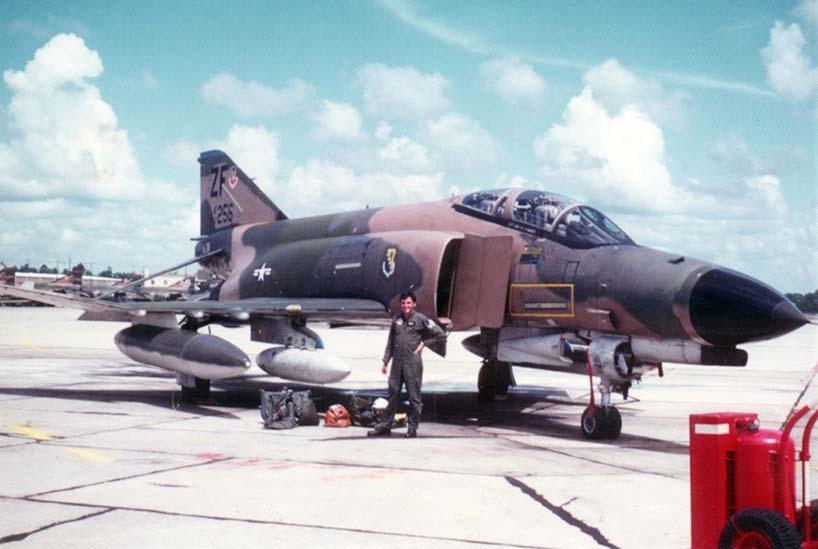
13 Feb 80 – F4E 68-427 – ferry a F4, with ‘MY’ Moody code on the tail, from Moody AFB, Georgia, to HAFB 1.2hrs

1 Mar 80 – F4E 69-258 I was in the rear seat of No 2 in a four aircraft flight (2B/4). I had an ‘In Flight Emergency’ (IFE) – the left engine Fire light came on, so I told the trainee pilot to shut down the engine and we carried out a single engine landing at HAFB. With F4 engines mounted close to the centreline, there was very little asymmetric effect in flying the F4 on only one engine.
18 Apr 80 – My first ‘Cross Country’ – F4E 67-336. from HAFB via Seymour Johnston AFB (Goldsboro, Nth Carolina) to Myrtle Beach AFB, South Carolina 1.9 hours refuel, then via Tyndall AFB, Florida, to Eglin AFB, Florida 2.0 hrs
19 Apr 80 – F4E 67-336 from Eglin to Bergstrom AFB (7NM SE of Austin, Texas) 1.7 hrs
20 Apr 80 – Bergstrom to Eglin AFB 1.5 hrs refuel, Eglin to HAFB 1.5 hrs
6 June 80 – F4E 67-245 ferry F4E to, and F4D from, the Programmed Depot Maintenance (PDM) facility at Hill AFB, Utah. From HAFB to England AFB, Louisiana 2.0 hrs refuel; to Tinker AFB, Oklahoma 1.2 hrs refuel; to Hill AFB, Utah, 2.0 hrs. Total 5.2 hrs. The F4D for our return flight ‘broke’ on start-up for the return flight and was not easily repairable so we were stuck in Salt Lake City for the weekend. We swam in the Salt Lake, visited the extensive Mormon Visitor Centre and records centre, and on Sunday listened to the famed Tabernacle Choir.
11 June 80 – F4D 65-690 – Hill AFB return to Hill AFB – dumped gas as gear stuck down
11 June 80 – F4D 65-690 – from Hill to Bergstrom AFB, TX 2.1 hrs, overnight stay
12 June 80 – F4D 65-690 – Bergstrom to HAFB 2.2 hours
19 June 1980 – F4E 66-309 the 31 TFW ’Turkey Shoot’ air-to-ground weapons contest was held between each of the four 31 TFW squadrons who fielded four aircraft each. I was the Flight leader of the four aircraft from the 309th so I flew from the front cockpit of the lead aircraft (1A/4). 309th were the overall Winners! I was in overall 3rd place. My IWSO and I were 15 secs late on the designated Time on Target (ToT) and for the two x RLD bombs set-up by the IWSO in the back seat on his radar and WRCS we scored US/12 (too ‘long’ to be scored!) and 270 yards at 6 o’clock – 270 yards was considered to be a ‘Hit’ with the simulated Tactical ‘Nuc’ bomb we dropped. My four bombs were dropped firstly from a 10 Deg LAB delivery – 21 yards at 12 o’clock (21/12), then a 30 Deg Dive bomb – 32/6, a 30 deg Pop-up – 28/3, and finally a 20 deg Pop-up – 44/4. My 10 deg strafe (two passes only at the acoustically scored target) with 100 x 20mm canon scored an excellent 42%.
20 June 80 – F4E 67-256 Annual Instrument & Rear Seat Qualification check – I was delighted to be awarded an ‘EQ’ (Exceptionally Well Qualified). Award of such EQs were restricted to less than 5% in 31 TFW! To say I was very surprised would be an understatement as I had been instructing on the F4E for only some 6 months.
30 Jun 80 to 18 July 80 – TAC Aces air-to-air simulator at Luke AFB, near Glendale, Arizona. Here I spent the first week as a student on the course and the next two weeks as an IP. Air-to-air fighting in the ‘sim’ was against another aircraft that could be programmed as either an F4, or a Mig 21. Each sortie was taped and replayed in a debrief. There was a steep learning curve in early sorties with importance placed on turning the aircraft at ‘Optimum AoA’ and ensuring the correct ’switcholgy’ – the selection of the correct switches to fire an Aim 7, or an Aim 9, or fire the 20mm canon. My family came with me to Glendale and we enjoyed visits to the scenic Grand Canyon, Monument Valley and Painted Desert on one weekend, and the second weekend to the huge ‘Bone-yard’ aircraft park at Davis Montham AFB, then to Nogales (Mexico) and to the old cowboy town of Boot Hill.
21-23 Jul 80 – ‘Regulations’ said I had to do a total of five flights including a ‘checkride’ to convert from the F4E to the F4D, and these were undertaken in a mixture of the front and back seats.
19/20/21/22 Aug 80 – four nights as an IP with 308th. On 19th ‘my’ student pilot ripped the Air Refuelling door back beyond its stops on F4D 65-721 causing damage to the skin of the F4. This happened after a ‘forward low disconnect’ from the boom of the KC135 Tanker. While hooked up and in a turn at around 30 degrees of bank at about 26,000 feet at night, the trainee pilot in the front seat saw he was dropping back at full ‘Military’ power so he selected both engines into minimum after-burner (AB). The correct technique for a trainee was to put one engine in ‘min-AB’ and then modulate power on the other engine in Mil-power to maintain the correct refuelling position. With both engines now in ‘min-AB’, the aircraft moved too far forward and the ‘boomer’ couldn’t withdraw the air refuelling probe from the F4s air refuelling receptacle fast enough. The F4 receptacle was on the top of the fuselage behind the rear cockpit. Now, as IP and Aircraft Commander it was ultimately my fault – but…… while air refuelling in the dark was in progress I initially became a bit ‘confused’ as I couldn’t see the ‘Boomer’ and the KC135 Director Lights very well because they were partially obscured by the rear view mirror that was positioned in a housing outside the aircraft at the top centre of the rear canopy. In the 309th F4Ds I had flown there were two mirrors, each placed internally on either side of the cockpit in the 2 o’clock and 10 o’clock positions forward of the canopy bow. The two mirrors in the F4E were also mounted inside the rear canopy. Clearly, I became a bit ‘fazed’ with my own problem so was thus a bit ‘behind the 8-ball’ and not properly monitoring the trainee pilot. It all happened very quickly. Afterwards I wrote a report to describe how it happened and said it was my fault – and thankfully nothing more eventuated. But the aircraft skin repair technicians had a little job to do to repair the F4.
29 Aug 80 – Cross Country # 2 F4D 65-743. HAFB to Kelly AFB, Texas 2.7 hrs, refuel; from Kelly to NAS Pt Mugu, California 2.7 hrs (to see Larry Pfitzenmaier USN former USN/RNZAF exchange who flew with 75 A4 Sqn at Ohakea for two years in the early 1970s).
30 Aug 80 – F4D 65-743 from Pt Mugu via the Grand Canyon to Davis Montham AFB, Az, 2.0 hrs refuel; DM to Luke AFB, Az 2.0 hrs.
31 Aug 80 –F4D 65-743 from Luke AFB to Tinker AFB, Oklahoma 2.1 hrs refuel, Tinker to Wright Patterson AFB, Ohio 2.0 hrs
1 Sep 80 – F4D 65-743 from Wright Patt to Eglin AFB, Florida 1.8 hrs refuel, Eglin to HAFB 1.5 hrs
3 Sep 80 – I was ‘reassigned’ from 309th TFS to 308 TFS at 31 TFW, HAFB, still on the F4D
18 Oct 80 – I flew as a passenger in a USAF C141A Starlifter 50272 of the 437th MAW via Charleston AFB, Nth Carolina, to Cold Lake AFB, Alberta, Canada for Ex Maple Flag VI. When at Cold Lake I flew the F4D four times in the first week in Strike packages, and the three times in the second week as an interceptor or as close escort to attackers. Other fighter aircraft present included CF-104 Starfighter, CF 101 Voodoo, CF5A Freedom Fighter, USAF F4, F15, A7D
20 Oct 80 F4D 65-490 Ex Maple Flag – Flight Leader of four aircraft (1A/4), Pop-up 10 deg LALD Strike on SA2 site on a ‘tactical’ airfield with ingress at 540K /300 feet using offset bombing target directions and egress initially at 1.2 Mach at 300 feet when chased by a RCAF CF101 Voodoo!
21 Oct 80 F4D 65-646 2A/2 Strike on Pontoon bridge 500K/300 feet level
22 Oct 80 F4D 65-648 2A/4 Strike on a ‘convoy’
23 Oct 80 F4D 65-648 3A/4 Strike on runway
27 Oct 80 F4D 65-490 Combat Air Patrol (CAP) – I claimed two CF5As ‘simulated’ as shot down (one with the radar guided Aim 7 Sparrow missile and one with heat seeking Aim 9 Sidewinder)
28 Oct 80 F4D 65-646 Fighter CAP & Escort – claimed one CF5A with Aim 7 and Aim 9 missiles and a ‘snapshot’ with the 20mm gun
29 Oct 80 F4D 65-585 CAP – mission aborted when Exercise flying was stopped as one of our F4Ds was lost with a tail-plane fire – the crew ejected safely. The cause was attributed to a failed welding on the jet-pipe casing and improper fitting of the heat blanket – Hill AFB took the rap.
29 Oct 80 – flew in Canadian Air Force CF5A Freedom Fighter serial 116812 ‘Aggressor’ for .8 hrs
30 Oct 80 F4D 65-648 Low Level Fighter CAP at 300 feet – engaged one B52 (Rollslide gunned at 1000 feet with 20mm canon), two C141 Starlifters, two C130 Hercules and eight A7D Corsairs.
31 Oct 80 – flew in CAF Lockheed Silver Star T33 133504 for 1 hour on weather check & handling
31 Oct 80 – F4D 65-585 – from Cold Lake AFB to Hector Airfield (the ‘Happy Hooligans’ Air Nat Guard Base), Fargo, Nth Dakota 1.6 hrs. Halloween night!
1 Nov 80 – F4D 65-585 – major hydraulic leak on startup – fixed by Nat Guard (a local chemist!). From Fargo to Wright Patterson, Dayton, Ohio AFB 1.7 hrs refuel, Wright Patt to HAFB 2.0hrs, night landing
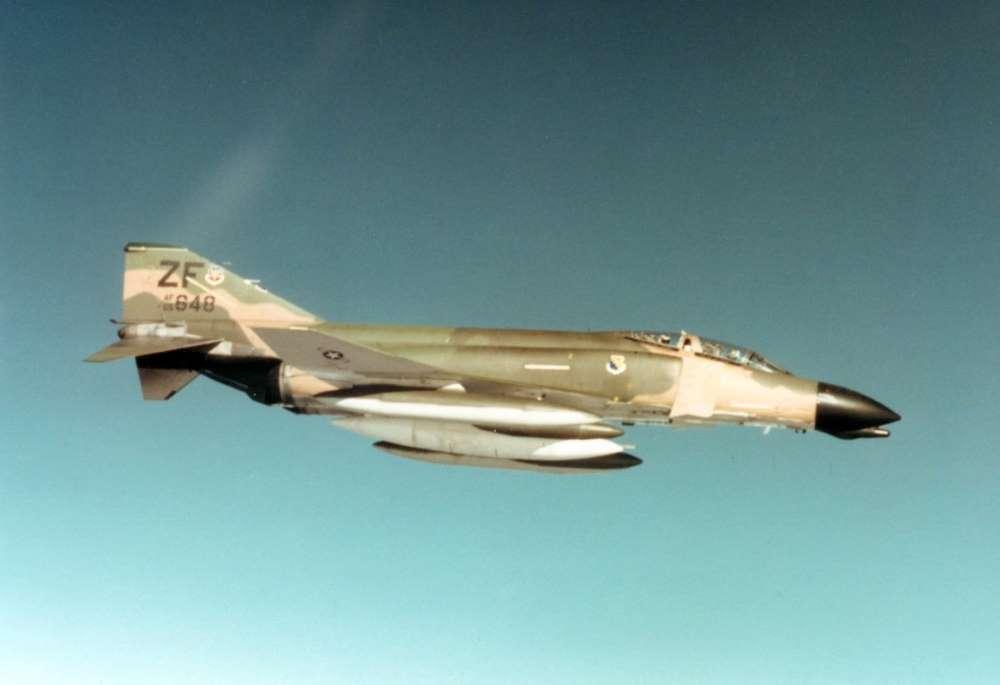
1st November 1980 F4D Phantom 65-468 flown by Capt Jackson USAF enroute from Hector Field, Fargo, to Wright Patterson AFB, Ohio, on return to Homestead AFB from Ex Maple Flag, Canada
14 Nov 80 – F4D 66-460 – IFE- Left Gen out, Bus Tie open, arrested landing from backseat (2B/2)!
4 Dec 80 – F4D 65-719 – Eglin AFB to HAFB collected F4D after rectification – 1.3 hrs
23 Jan 81 – Cross Country # 3 F4D 66-468 – from HAFB to England AFB, La 2.0 hrs refuel, to Holloman AFB New Mexico 1.8 hrs refuel, to Canon Intl, Reno, Nevada (ANG) 1.9 hrs
24 Jan 81 – F4D 66-468 Reno to Holloman AFB 1.9 hrs refuel, to Hensley Field NAS Dallas 1.3 hrs
25 Jan 81 – F4D 66-468 NAS Dallas to HAFB 2.2 hrs
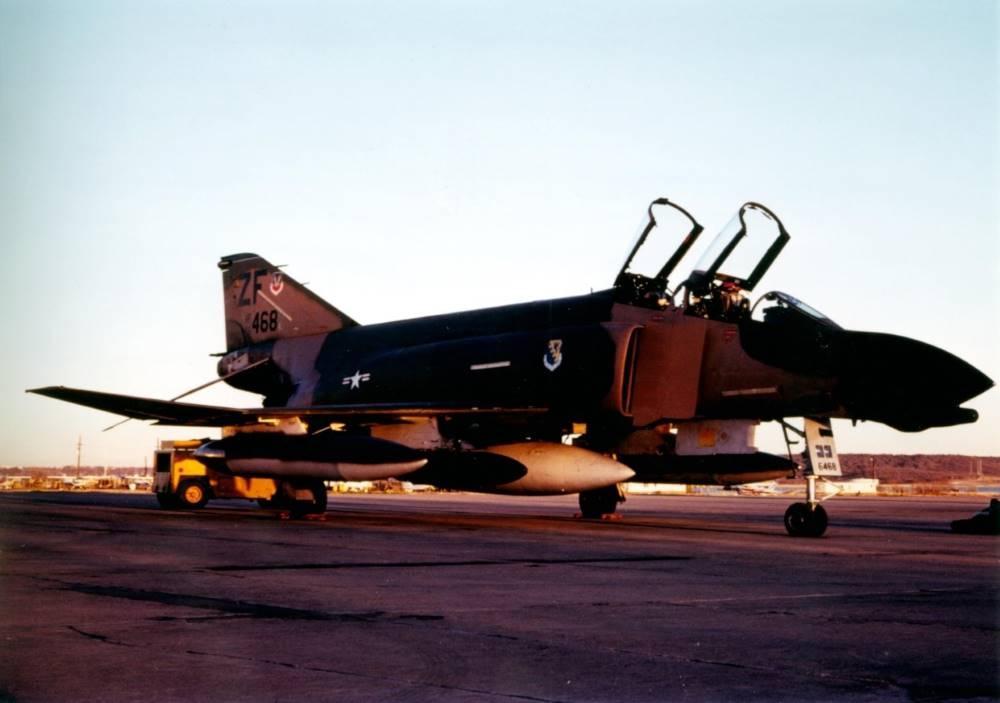
2 May 81 – F4D 66-467 Kiwi ‘Burner Bust’ taking my wife Joanie Barclay. Once each year the 308th reached out to IP/IWSO’s wives to show them a little of what their husbands did ‘at work’. They visited the F4 Simulators, had a visit to the Egress and Safety shop (and tried out the parachute hanging harness rig), had a briefing by the CC 308th – and a selected few experienced a ‘Burner Bust’. This involved donning a nomex flying suit (the ‘green bag’) all the flying gear and helmet/mask, strapping in to an F4 for engine start-up, making the radio call to taxy to the runway holding point, closing the rear canopy and lining up on the runway, experiencing the start of takeoff roll with both afterburners engaged, and then aborting the takeoff before taxying back to dispersal. The programme was well received!
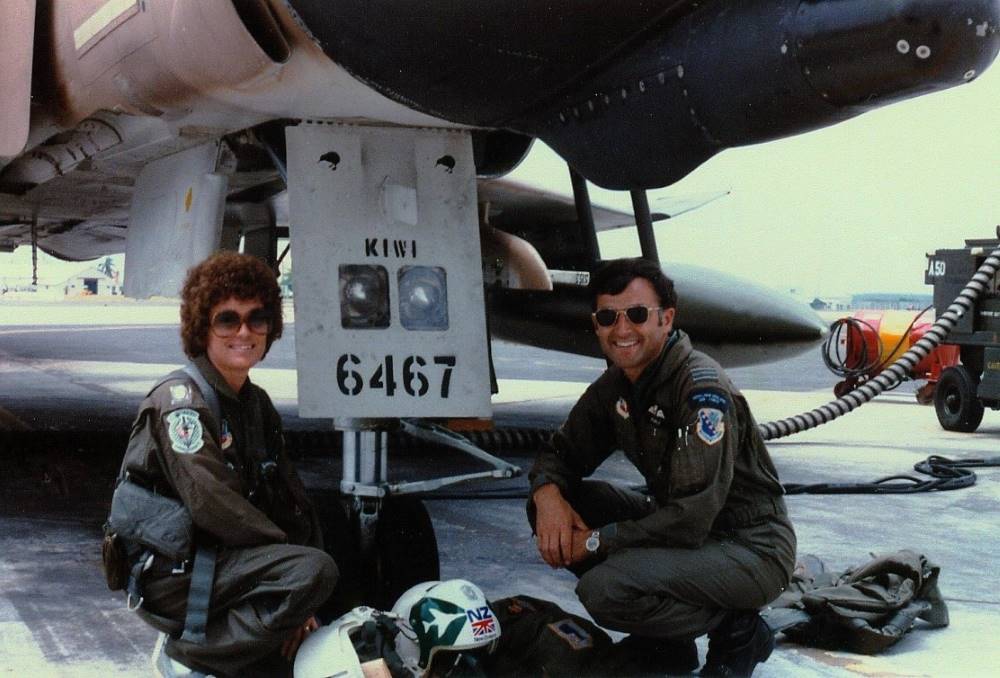
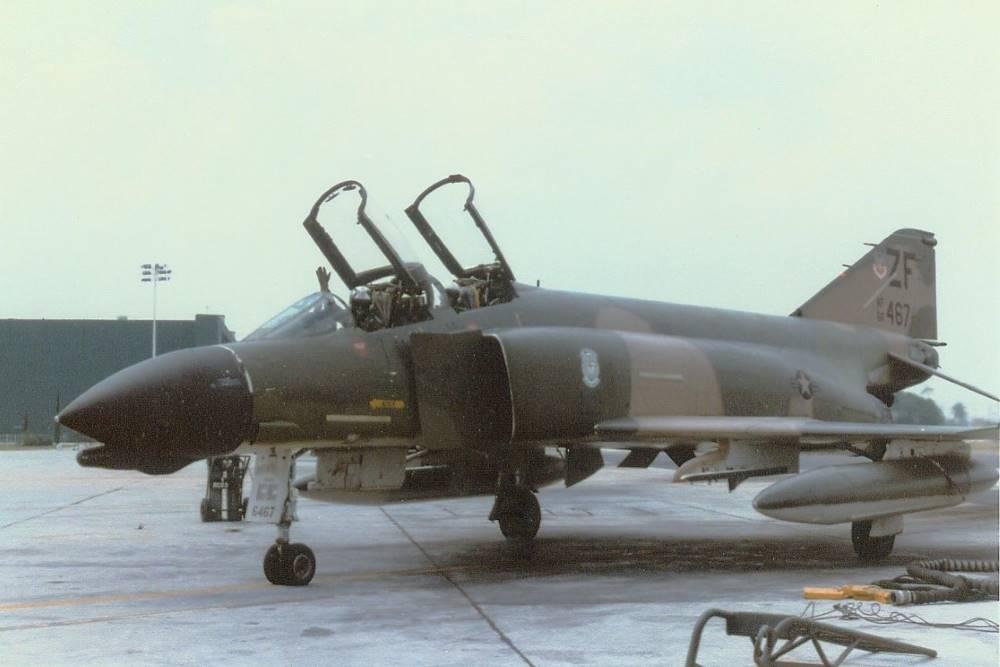
28 May 81 – Cross Country #4 F4D 65-721 HAFB to NAS New Orleans 1.7 hrs
29 May 81 – F4D 65-721 New Orleans to McConnell AFB, Wichita, Kansas 1.7 hrs refuel; to Peterson Field AFB Colorado Springs 1.3 hrs.
30 May 81 – visit the USAF Academy
31 May 81 – F4D 65-721 from Peterson Field to England AFB, La 1.8 hrs refuel, to HAFB 1.7 hrs
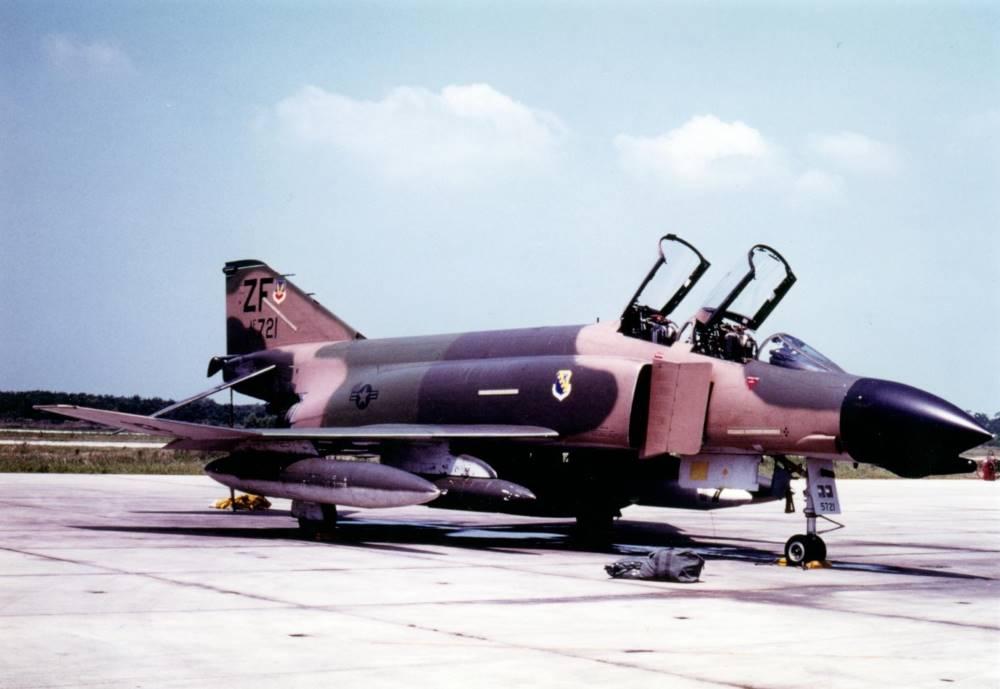
18 Dec 81 – Cross Country # 5 F4D 66-467 HAFB to England AFB, La 2.1 hrs refuel, to Cannon AFB, New Mexico 1.5 hrs refuel, to Nellis AFB, Nv 1.5 hrs
20 Dec 81 – F4D 66-467 Nellis to NAS Dallas 2.2 hrs refuel, to Eglin AFB, FL 1.3 hrs at night
21 Dec 81 – F4D 66-467 Eglin to HAFB 1.2 hrs
26 Jan 82 – F4D 66-497 – final F4 flight 1.2 hrs
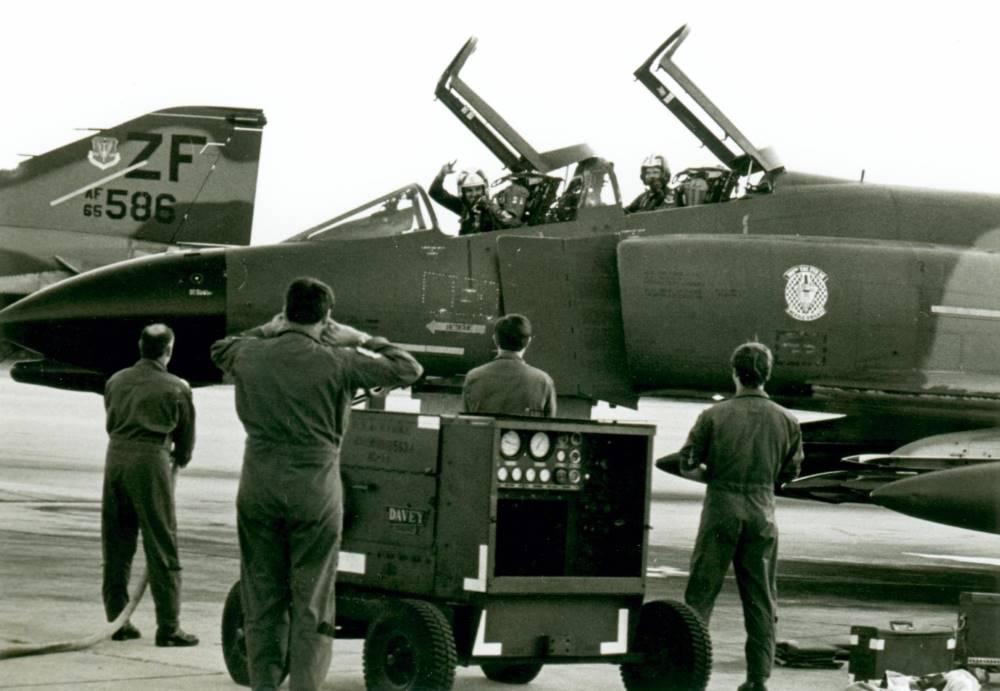
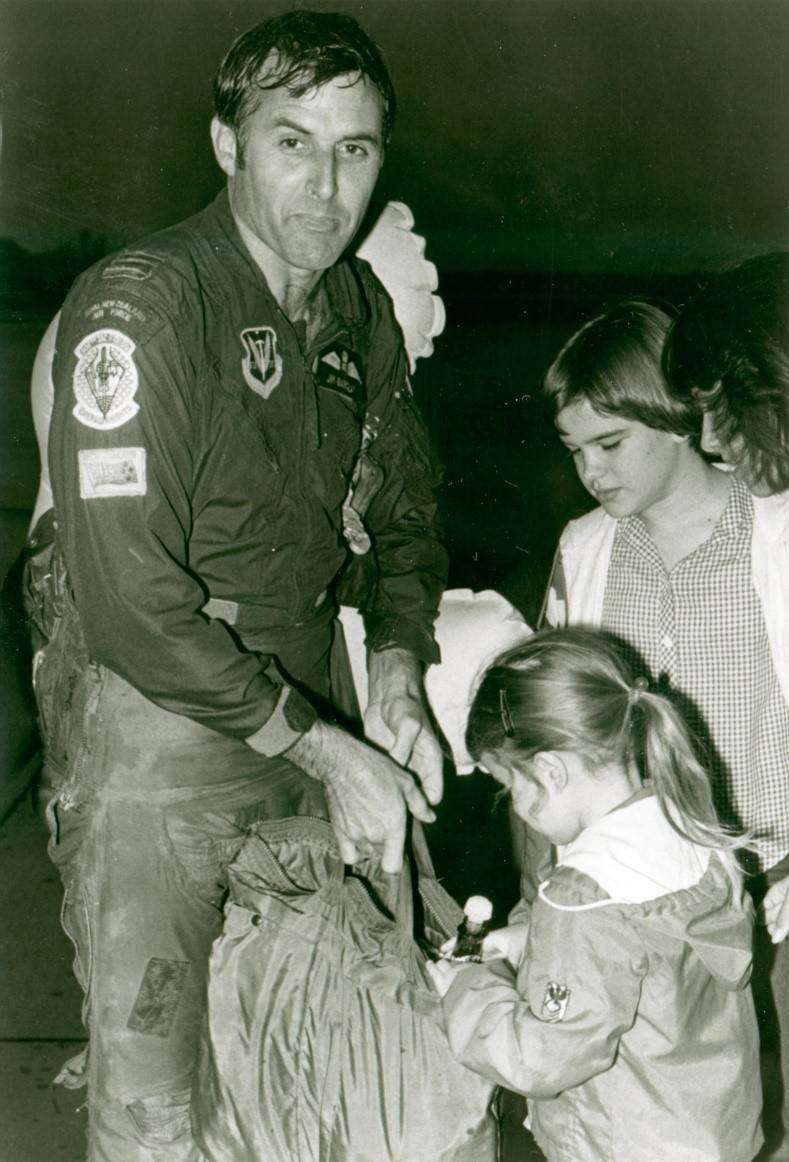



Greg Elliott
Posted at 15:21h, 13 JulyGreat piece of history Jim – you’ve obviously got inspired to write it down before it disappears after all these years. That ‘Burner Bust’ must’ve been a blast! Enjoyed the read – there wasn’t much viz on the NZ side of what you all did in USA, except that we couldn’t understand your lingo when you came back – but you obviously brought back a great grasp of fighter tactics!
Jim Barclay
Posted at 18:11h, 13 JulyNice to hear from your Greg! You are correct – Fighter tactics a different language that I am pleased the RNZAF finally adopted with the Kahu Update.
I was disappointed when I got back to Ohakea in early 1982 to find the Skyhawk was still being flown as if it were a bomber that in turn had replaced the Canberra in 1970; and here, 12 years later in 1982, it was still be being flown as if it were ‘just’ a bomber. By teaching fighter tactics to the young 14 Sqn Strikemaster pilots (when I was the ‘Boss’ of 14 Sqn in 1982-83), I reaped the benefit in 1984-1985 when I was CO 75 (Skyhawk) Sqn: we started to fly the A4 to use ALL of its capabilities as a fighter/attack aircraft. I believe we did well in exercises such as Ex Cope Thunder ’84 in the Philippines, Ex Triad in NZ, Ex Blue Denim in Australia etc.
Where are you now? Email me at jimbarclay.co.nz
With kind regards,
Jim
Garry Beckham
Posted at 11:50h, 28 SeptemberJim you and I went on a Cross Country to Bergstrom AFB , Texas and spent the night with my father-in-law while you were in the 309th… must have been late 1979 early 1980…I went to Clark AB Philippines in Aug 1980.. I was an IWSO at the time. Nice article. Garry Beckham, BEEKMAn
Garry Beckham
Posted at 13:22h, 28 SeptemberFlew with you cross country to Bergstrom. We spent the night at Bergstrom, visited the LBJ Library. Must of been late 1979 early 1980. I left for Clark AB, Philippines in August 1980. We were in the 309th TFTS together. Great to see you are doing well…Last time I saw you was around 40 years ago. Cheers! Garry “Beekman” Beckham, IWSO… P.S. Mike Major was the commander of the 309th at the time.
Jim Barclay
Posted at 15:14h, 28 SeptemberHi Garry,
So nice to hear from you after all these 40 years !!
My logbook shows we flew in F4E 67-336 on 18th April 1980 from Homestead AFB to Seymour Johnson AFB where I shot a TAC/GCA for a touch and go, then on to Myrtle Beach AFB to refuel (2.0hrs flight time). Then on the same day we flew from Myrtle Beach across Georgia to Eglin AFB in Florida for a GCA, missed approach to a GCA at Tyndall AFB, followed by a GCA to land at Eglin (2 hours flight time) where we spent an overnight.
On 19th April we flew from Eglin via Mobile Alabama, New Orleans Louisiana, Houston Tx, Austin Tx to Bergstrom AFB Tx in 1.7 hours. We visited the LBJ library, which I remember well !! And our visit to Austin.
On 20th April we did two hops to home – the first was from Bergtsrom to Houston to New Orleans to Mobile to Pensacola to land and refuel at Eglin taking 1.5 hours. Then on from Eglin (armed with shrimp from the Mary Ester Fish House in the travel pod !!) to Panama City-Tallahassee-St Petersburg-Tampa for a SRA approach at MacDill AFB and then on to Sarasota-Fort Myers-Homestead AFB in 1.5 hours.
What a great trip with good company ! I was very lucky to be seeing USA like that.
My wife, Joanie, remembers you well as you pushed her into the swimming pool (at McConnell’s?) fully clothed in her fine green woollen suit – (green for the St Patrick’s Day party we were at) = NOT impressed!
I flew in Ex Cope Thunder ’84 from Clark AFB. We were there for two weeks and I was CO 75 (A4K Skyhawk) Squadron. Maris McCrab was there at that time – were you still there ?
Happy days, great memories,
Cheers,
Jim
Stu Mosbey
Posted at 02:01h, 29 SeptemberJim, I was the Cope Thunder commander when you brought your squadron. Great memories. Sadly, Maris” Buster”
McCrabb has recently passed away.
Jim Barclay
Posted at 08:37h, 29 SeptemberHi Stu,
You did a great job as Cope Thunder Commander! I’m sorry to hear that Maris has passed away. I was his Flight Commander on the 308TFTS at Homestead AFB in about 1980/81 – he was not long back as a grad from from Weapons School and together we had to turn around the Air to Ground Flight before a MEI. We passed the MEI! Later, I was very surprised to see him at Cope Thunder 84-7!
For Cope Thunder 84-7 we arrived at Clark AB with 8 Skyhawks on 5th September 1984 having been in Singapore since 15th August. The learning curve at Coper Thunder was steep for my pilots, and I’m pleased to say they acquitted themselves very well. All went well in the first week working hunter-killer sorties against Sam sites on Crow Valley range with the F4G Wild Weasels, and DCA against F15, F16, F4E, F4G, A7E, C130, T33 and F5 Aggressors. At the end of the first, back home in New Zealand, the NZ Govt announced its anti-nuclear policy after which Uncle Sam held us at arm’s length – gone was the invitation to play golf with General (?? – forgotten his name), have drinks and dinner at the General’s home together with our visiting RNZAF one-star. Notwithstanding, we enjoyed the second week of exercise flying very much. Like Red Flag and Maple Flag, Cope Thunder was an excellent way of introducing pilots to what it might be like to fly and fight under combat conditions. I felt very privileged to have led my Squadron at Cope Thunder !
We left Clark AB for home on 24th September 1984, and flew for 3.5 hours to Biak (Indonesia) to refuel, then on for another 3.1 hours to RAAF Townsville, (Queensland) for an overnight. Next day we flew for 1.3 hours to RAAF Amberley (Queensland) to top up gas, then to 3.2 hours home base at Ohakea, NZ. Just days later, we were into DACT with the visiting USAF F16s that came to Ohakea for Ex Triad 84 that ran from about 5th till 9th October 1984; because of NZ’s anti-nuclear stance, this was the last contact with the USAF for many, many years.
With kind regards,
Jim
Allan Borg Ssgt USAF
Posted at 13:55h, 10 JanuaryI really appreciate the story of the training new pilots received. it was my job as a weapons control system mechanic to maintain the radar and bombing computers for our pilots and in both Germany and in the Vietnam War based out-of Ubon Thailand. thank you for sharing
Rick Ketchum
Posted at 11:30h, 05 MarchHi I was your crew chief on 66-467 AT HOMESTEAD AFB.
Rick Ketchum
Posted at 11:35h, 05 MarchI am the crew chief that gave the name to my aircraft (KIWI) AND ON YOUR LAST BRIEFING I WAS ABLE TO ATTEND AND I PRESENTED YOU A MODEL OF 66-467 kiwi.
Rick Ketchum
Posted at 11:40h, 05 MarchCan you send me an email address for you
Joe Love
Posted at 03:04h, 14 JulyKIWI, I don’t know if you remember me or not, but I do remember you. I was an IWSO at Homestead from November ’78 to October ’81 and was in the 306th, 309th and Stan Eval while there. I may have missed it, but I did not see anything of one specific event that I recall. Wasn’t it you that shot down the balloon that broke its moorings down at Key West? My most memorial event at Homestead came while I was on alert in the F4D. NK02 got sent on a round-robin radio check around Florida so we were sitting solo alert when we got an active scramble. A fast moving Mig was coming up out of Cuba, and I took a “Judy” from GCI at about 35 miles (an almost unbelievable distance for a mig-sized target). We were fully loaded with four Aim-7s, four Aim-9s and the gun pod and were cleared to “green ’em up.” As I recall it, at around 20-25 miles, the Vc began to drop as the contact began to drift left doing a 180 turn to home base. I have to admit that the adrenalin was pumping and the butterflies in my stomach were going crazy.. Just another day at the office I guess. Good to hear from you. Hope all is well in KIWILAND.
Cheers!
Jim Barclay
Posted at 19:26h, 15 JulyHi Joe,
Thanks for your comments!
I was on 306th doing 80 AIH (IP Course) from Oct 79-Jan 80. LTC Omer L Ward was Ops Officer, and Charles E Guthrie was Commander 306th TFTS.
In answer to your question – no it wasn’t me that fired on the weather balloon. However, I remember being at Commanders call on a Friday night at the O Club when a presentation was made to the pilot and WSO of that F4; and the hoots and catcalls that came from the audience of fighter jocks was hilarious as in “how could you shoot at a poor defenseless balloon with a mighty Aim 7 Sparrow missile” etc etc, and “fighter jocks shoot at real the enemy, not loose balloons” !! etc. All in good fun. Happy days and nice thoughts to look back on.
Hope you’re keeping well?! AGE creeping up on us is not a blessing!
With best wishes,
Jim
Joe Love
Posted at 08:12h, 21 JulyJim,
Wow! My almost 78 year-old memory is definitely failing me. I would have sworn in court that it was you that shot down the balloon. I’m thinking that means that AGE is not creeping up – it has arrived and is in full bloom.
I’m sure you have heard of the assassination attempt on former president and current republican nominee for president, Donald Trump. Keep the USA in your prayers. It looks like we can use all the prayers we can get.
Cheers,
Joe Bear
Joe Love
Posted at 00:54h, 18 AugustKIWI,
Well, I guess old age decided to stop creeping and charged ahead like bull going for a matador. After some chest pain I spent five days in the hospital. Heart is okay, but I seem to have enlarged aorta (aneurysm) that they will check every six months or so. And to think I used to fly with this body!
Cheers!
JoeBear